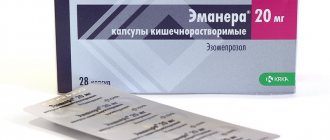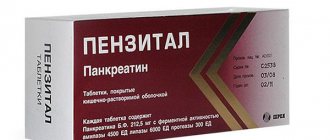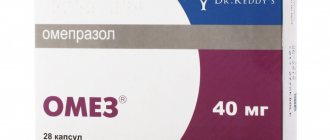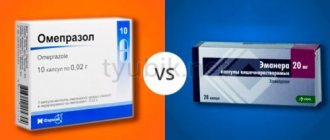Pharmacodynamics and pharmacokinetics
Pharmacodynamics
Irreversibly binds to the enzyme H+/K+-ATPase, known as the proton pump. Its activity is inhibited, which leads to a decrease in basal and stimulated secretion. The effect of the drug depends on the dose. The effect appears after 1 hour, and maximum after 2 hours and lasts 24 hours. After treatment, secretion returns to normal within a week. When taking 20 mg, acidity decreases by 90% and by 94% when taking 40 mg.
Pharmacokinetics
Absorption occurs in the small intestine within 3-6 hours. Cmax in the blood after 0.5–1 hour. Bioavailability is 35%. Bioavailability increases in the elderly and with impaired liver function. Metabolized in the liver. Excreted by the kidneys (70%) and bile (30%).
Interactions of the drug Ultop
Cases of interaction of omeprazole with other drugs are rarely reported. Possible interaction with drugs that are metabolized in the liver with the participation of cytochrome P450 enzyme systems. The concentrations of diazepam, phenytoin, nifedipine, warfarin, aminopyrine and disulfiram may increase with simultaneous use of omeprazole. As a rule, such an increase is not significant for the clinic when using omeprazole in usual doses. However, it is recommended to monitor the patient's condition at the beginning of treatment and when stopping the drug, if necessary, adjust the doses of diazepam, phenytoin, warfarin and disulfiram accordingly. With simultaneous use, the concentration of both clarithromycin and omeprazole in the blood plasma may increase. As a result of reduced acidity of the stomach contents, the absorption of ampicillin, ketoconazole and iron supplements may change. The effectiveness of prednisolone and cyclosporine may be reduced, so sometimes it is necessary to adjust the dose of cyclosporine. With the combined use of antacids, amoxicillin, digoxin, theophylline, lidocaine, quinidine, metoprolol or propranolol, no clinically significant interaction was observed.
Indications for use of Ultop
- gastroesophageal reflux;
- erosive gastritis and duodenitis that occurred while taking NSAIDs;
- peptic ulcer;
- eradication of Helicobacter pylori (in complex therapy);
- stress and peptic ulcers;
- Zollinger-Ellison syndrome.
Indications for use of 10 mg capsules:
- symptoms of dyspepsia (for example, heartburn);
- short-term therapy;
- anti-relapse treatment;
- prevention of ulcers and erosions when taking NSAIDs.
Side effects
- diarrhea or constipation , flatulence , dry mouth, vomiting , stomatitis , transient increase in liver enzymes;
- insomnia , headache , agitation, dizziness , depression , hallucinations , encephalopathy (in severe liver diseases);
- tachycardia , angina pectoris , increased blood pressure, peripheral edema;
- interstitial nephritis, the appearance of protein, red blood cells and sugar in the urine, increased creatinine in the blood;
- in men - enlarged mammary glands and pain in the testicles;
- cramps , arthralgia , bone pain, myalgia ;
- agranulocytosis, thrombocytopenia, anemia, leukopenia, neutropenia;
- dry skin, itching , rash, alopecia ;
- cough, nosebleeds;
- visual disturbances, ringing in the ears;
- fatigue, weakness, weight gain.
Ultop, instructions for use (Method and dosage)
Capsules are taken orally, without chewing, before meals with a small amount of liquid. The duration of the appointment is determined by the doctor.
For exacerbation of duodenal ulcer - 20 mg/day.
For GERD - 20 mg, for severe GERD 40 mg before breakfast with transition to maintenance treatment.
For gastric ulcers and esophagitis - 20–40 mg/day.
Erosion while taking NSAIDs - 20 mg/day.
Eradication of Helicobacter pylori - 20 mg 2 times a day. in combination with antibacterial agents. For the purpose of prevention - 10 mg / day.
Zollinger-Ellison syndrome - start with 60 mg/day. Possible increase to 120 mg/day.
Instructions for use of Ultop must be followed to avoid overdose and side effects.
Use of the drug Ultop
Adults Peptic ulcer of the stomach, including ulcers associated with taking NSAIDs - 20 mg (1 capsule) 2 times a day, morning and evening, for 2-6 weeks. Peptic ulcer of the duodenum - 20 mg (1 capsule) 2 times a day, morning and evening, for 2-4 weeks. Gastroesophageal reflux disease - 20 mg (1 capsule) 2 times a day, morning and evening, for 4–8 weeks; maintenance therapy - 1 capsule once a day for 12 months. Chronic gastritis with increased acid-forming function of the stomach in the acute stage - 20 mg (1 capsule) 2 times a day, morning and evening, for 2-3 weeks. Non-ulcer dyspepsia - 20 mg (1 capsule) 2 times a day, morning and evening, for 2-3 weeks. Ultop in 10 mg capsules is usually used at a dose of 10 or 20 mg/day for 2–4 weeks; If symptoms do not disappear within 4 weeks of therapy or reappear soon after stopping treatment, the patient's diagnosis should be reconsidered. Eradication of Helicobacter pylori - 20 mg (1 capsule) 2 times a day, morning and evening (in combination with antimicrobial agents). Zollinger-Ellison syndrome and other conditions associated with hypersecretion of gastric juice - the dose of the drug and the duration of treatment are determined individually. The recommended initial dose is 60 mg/day; while continuing treatment, the dose is gradually increased taking into account the patient's response to the therapy. If the daily dose exceeds 80 mg, it should be divided into 2 doses. Treatment lasts until clinical manifestations disappear. Some patients took 120 mg of omeprazole per day, divided into 3 doses. Prevention of recurrence of duodenal ulcers - usually the dose is 10 mg (1 capsule) 1 time per day. Long-term maintenance treatment to prevent relapses of gastroesophageal reflux - to prevent the onset of symptoms or for endoscopically unconfirmed gastroesophageal reflux, the recommended dose is 10 mg / day (1 capsule) before meals. If symptoms of the disease recur, the dose of the drug should be increased. To prevent relapse of erosive esophagitis, the recommended dose is 20 mg (1 capsule), the drug should be taken before breakfast. The safety and effectiveness of maintenance therapy for 12 months has been proven. Children over 2 years of age For the treatment of erosive esophagitis in children, it is recommended to use the drug at a dose of 0.7–1.4 mg/kg body weight per day. Typically, the duration of treatment is 8 weeks; if necessary, treatment can be continued for another 12 weeks. The dose and duration of treatment are determined individually. The daily dose should not exceed 40 mg. The drug should be taken in the morning, before breakfast. If the child cannot swallow the capsule, it can be opened and the contents mixed with a small amount (1 tablespoon) of apple juice or yogurt. Care must be taken to ensure that the child swallows the drug immediately without chewing.
Overdose
It has been established that patients tolerate a dose of up to 360 mg well.
In case of an overdose , nausea, drowsiness, dizziness, tachycardia, blurred vision, increased sweating, agitation , and in rare cases, convulsions occur .
Treatment is symptomatic.
Ultop drug overdose, symptoms and treatment
Information on overdose of omeprazole is very limited. Patients tolerated omeprazole well at a daily dose of 360 mg. In case of overdose, abdominal pain, drowsiness, headache, dizziness, increased sweating, dry mouth, tachycardia, visual disturbances may occur; in rare cases, convulsions, difficulty breathing and hypothermia may develop. There is no specific antidote. Most of omeprazole binds to plasma proteins, so hemodialysis is ineffective. Treatment is symptomatic, and gastric lavage is performed and activated charcoal is prescribed.
special instructions
Ultop is recommended to be taken before meals, since food intake somewhat slows down absorption. If you have difficulty swallowing the capsule, its contents can be mixed with juice and the suspension can be drunk.
In children who take the drug for a long time, vitamin B12 .
Due to the sucrose content, Ultop is not recommended for use in patients with glucose-galactose malabsorption syndrome.
In normal dosages, the drug does not affect the speed of reactions when driving, however, it should be remembered that dizziness, visual disturbances and drowsiness .
Special instructions for the use of the drug Ultop
Ultop should be taken on an empty stomach, preferably in the morning before breakfast, since food intake slows down the absorption of omeprazole. In alcohol drinkers, no changes in the pharmacokinetics and metabolism of ethanol were observed when taking omeprazole. Before starting treatment, it is necessary to exclude the presence of a malignant process in the upper parts of the digestive tract, since taking Ultop can eliminate the symptoms of cancer. No dose adjustment is required for elderly patients or patients with impaired renal function. Dialysis performed in patients with chronic kidney disease does not affect the pharmacokinetics of omeprazole. The dose of the drug for patients with liver cirrhosis should not exceed 20 mg/day. The bioavailability of omeprazole increases in patients with liver cirrhosis, but no increase in drug toxicity was observed. The safety of omeprazole during pregnancy has not been established. Use is possible only if the expected benefit from the therapy exceeds the possible risk to the fetus. Breastfeeding is not recommended during treatment with the drug. The drug does not affect the ability to drive vehicles or perform work using technical means that require quick reactions.
Analogues of Ultop
Level 4 ATC code matches:
Khairabesol
Noflux
Lancid
Barol
Beret
Ontime
Gastrozol
Omeprazole
Pantoprazole
Proxium
Lansoprazole
Zulbex
Epicurus
Pariet
Losek MAPS
Losek
Sanpraz
Emanera
Omez Insta
Omez
Gastrozole , Losek, Omeprazole, Omez, Ulcazole, Bioprazole, Ornatol . All these analogs of Ultop have the same active ingredient.
Reviews about Ultop
Ultop: reviews from doctors
According to reviews from practicing doctors, when treating acid-related diseases, it is better to take high-quality generics, which include Ultop. Among the omeprazoles presented in Russia, only this drug has bioequivalence with the original omeprazole, which has been proven in German laboratories.
In clinical trials in the gastroenterological department of MONIKI named after. M.F. Vladimirsky Ultop showed high efficiency in combination with clarithromycin and amoxicillin during anti-Helicobacter therapy. Its clinical effectiveness is manifested in the rapid relief of symptoms (primarily heartburn) and the healing of erosive and ulcerative defects. After treatment, long-term remission occurs.
Reviews from patients indicate that Ultop is a combination of effectiveness, good tolerability and a reasonable price.
Ultop®
The effect of omeprazole on the pharmacokinetics of other drugs
A decrease in the secretion of hydrochloric acid in the stomach during treatment with omeprazole and other proton pump inhibitors can lead to a decrease or increase in the absorption of other drugs, the absorption of which depends on the acidity of the environment.
Like other drugs that reduce gastric acidity, treatment with omeprazole may result in decreased absorption of posaconazole, erlotinib, vitamin B12 (cyanocobalamin), ketoconazole and itraconazole, and increased absorption of drugs such as digoxin. The simultaneous use of omeprazole at a dose of 20 mg 1 time per day and digoxin increases the bioavailability of digoxin by 10% (the bioavailability of digoxin increased by up to 30% in 20% of patients).
Omeprazole has been shown to interact with some antiretroviral drugs. The mechanisms and clinical significance of these interactions are not always known. An increase in pH during omeprazole therapy may affect the absorption of antiretroviral drugs. Interaction at the level of the CYP2C19 isoenzyme is also possible. With the simultaneous use of omeprazole and some antiretroviral drugs, such as atazanavir and nelfinavir, a decrease in their concentration in the blood serum is observed during omeprazole therapy. In this regard, the simultaneous use of omeprazole with antiretroviral drugs such as atazanavir and nelfinavir is not recommended.
With the simultaneous use of omeprazole and saquinavir, an increase in the concentration of saquinavir in the blood serum was noted; when used with some other antiretroviral drugs, their concentration did not change.
Omeprazole inhibits the CYP2C19 isoenzyme, the main isoenzyme involved in its metabolism. Concomitant use of omeprazole with other drugs metabolized by the CYP2C19 isoenzyme, such as diazepam, warfarin (R-warfarin) or other vitamin K antagonists, phenytoin and cilostazol, may lead to a slower metabolism of these drugs. It is recommended to monitor the concentration of phenytoin in the blood plasma during simultaneous use of phenytoin and omeprazole. At the same time, in patients taking phenytoin for a long time, simultaneous use of omeprazole at a dose of 20 mg 1 time per day does not cause a change in the concentration of phenytoin in the blood plasma.
When using omeprazole in patients receiving warfarin or other vitamin K antagonists, monitoring of the international normalized ratio (INR) is necessary; in some cases, it may be necessary to reduce the dose of warfarin or another vitamin K antagonist. At the same time, in patients taking warfarin for a long time, simultaneous use of omeprazole at a dose of 20 mg 1 time per day does not cause a change in coagulation time.
The use of omeprazole at a dose of 40 mg 1 time per day leads to an increase in Cmax and AUC for cilostazol and one of its active metabolites.
A pharmacokinetic/pharmacodynamic interaction has been noted between clopidogrel (loading dose 300 mg and maintenance dose 75 mg/day) and omeprazole (80 mg/day orally), which leads to a decrease in exposure to the active metabolite of clopidogrel and a decrease in the maximum inhibition of ADP-induced platelet aggregation. The clinical significance of this interaction is unclear. There is no proven increase in the risk of cardiovascular complications with simultaneous use of clopidogrel, acetylsalicylic acid (ASA) and proton pump inhibitors, including omeprazole at a dose of 20 mg/day. The results of a number of observational studies are contradictory and do not provide a clear answer about the presence or absence of an increased risk of thromboembolic cardiovascular complications during the simultaneous use of clopidogrel and proton pump inhibitors.
When clopidogrel was used concomitantly with a fixed combination of 20 mg esomeprazole and 81 mg ASA, exposure to the active metabolite of clopidogrel was reduced by almost 40% compared with clopidogrel monotherapy, while the maximum levels of inhibition of ADP-induced platelet aggregation were the same, which is likely due to simultaneous administration ASA in low dose.
Omeprazole does not affect the metabolism of drugs metabolized by the CYP3A4 isoenzyme, such as cyclosporine, lidocaine, quinidine, estradiol, erythromycin and budesonide.
There was no effect of omeprazole on the following drugs: antacids, caffeine, theophylline, quinidine, lidocaine, piroxicam, diclofenac, naproxen, metoprolol, propranolol and ethanol.
With the simultaneous use of omeprazole and acrolimus, an increase in the concentration of tacrolimus in the blood serum was noted.
In some patients, a slight increase in the concentration of methotrexate in the blood plasma was observed during simultaneous use with proton pump inhibitors. When prescribing high doses of methotrexate, the possibility of temporary withdrawal of omeprazole should be considered.
Effect of drugs on the pharmacokinetics of omeprazole
The isoenzymes CYP2C19 and CYP3A4 are involved in the metabolism of omeprazole. The simultaneous use of omeprazole and inhibitors of the CYP2C19 and CYP3A4 isoenzymes, such as erythromycin, clarithromycin and voriconazole, may lead to an increase in the concentration of omeprazole in the blood plasma by slowing down the metabolism of omeprazole. Concomitant use of voriconazole and omeprazole results in a more than twofold increase in the AUC for omeprazole. Due to the good tolerance of high doses of omeprazole, short-term simultaneous use of these drugs does not require dose adjustment of omeprazole.
Drugs that induce the CYP2C19 and CYP3A4 isoenzymes, such as rifampicin and St. John's wort preparations, when used simultaneously with omeprazole, may lead to a decrease in the concentration of omeprazole in the blood plasma by accelerating the metabolism of omeprazole.
Concomitant use of omeprazole with amoxicillin or metronidazole does not affect the concentration of omeprazole in the blood plasma.
Ultop price, where to buy
You can buy the drug in pharmacies, a list of which is presented on the website of the Federal Information Service www.poisklekarstv.ru. Information is updated daily. The price for Ultop 20 mg No. 28 ranges from 148 rubles. up to 337 rub.
- Online pharmacies in RussiaRussia
ZdravCity
- Ultop capsules ksh/sol.
20 mg 28 pcs Krka-Rus LLC 305 rub. order - Ultop capsules ksh/sol. 40mg 28pcsKrka-Rus LLC
RUB 477 order
- Ultop capsules enteric solution. 20 mg 14 pcs. Krka-Rus LLC
170 rub. order
- Ultop capsules ksh/sol. 10mg 28pcsKrka-Rus LLC
RUB 205 order








